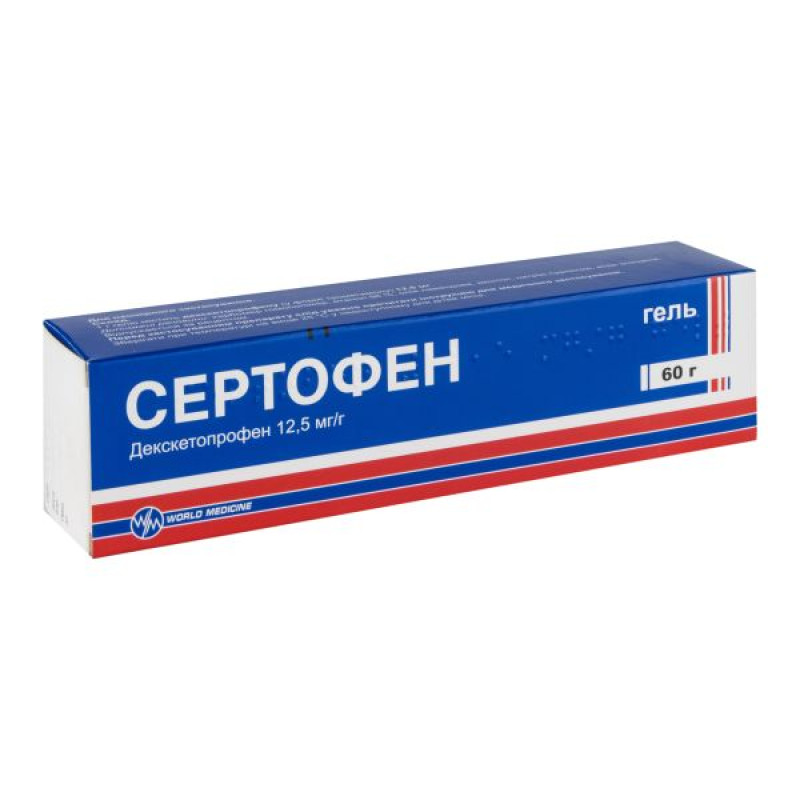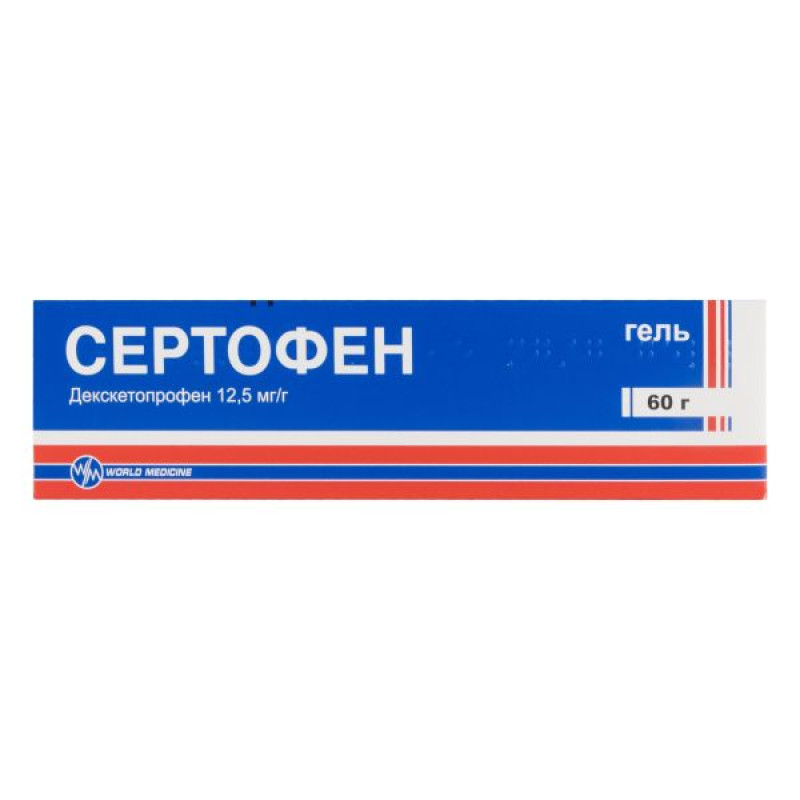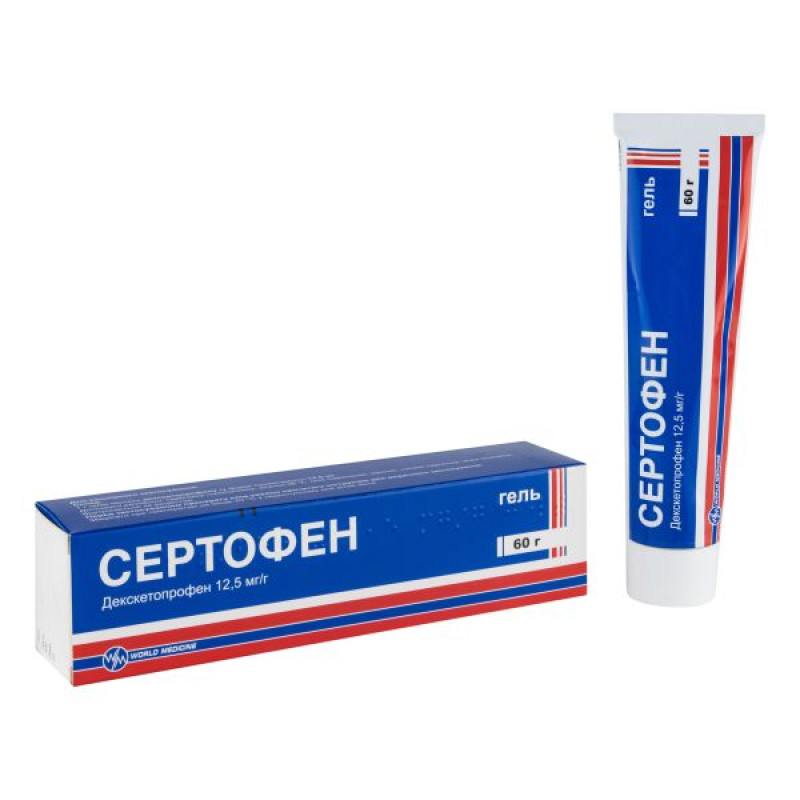Sertofen gel 12.5 mg/g 1.25% tube 60 g

Instructions Sertofen gel 12.5 mg / g 1.25% tube 60 g
Composition
active ingredient: dexketoprofen;
1 g of gel contains dexketoprofen (in the form of trometamol) 12.5 mg;
excipients: carbomer homopolymer, ethanol 96%, lavender oil, menthol, sodium hydroxide, purified water.
Dosage form
Gel.
Main physicochemical properties: opaque grayish-white gel, homogeneous, with the smell of lavender, mint and alcohol.
Pharmacotherapeutic group
Nonsteroidal anti-inflammatory drugs for topical use. ATX code M02A A27.
Pharmacological properties
Pharmacodynamics
Dexketoprofen trometamol is the tromethamine salt of (S)-(+)-2-(3-benzoylphenyl)propionic acid and the active enantiomer of the nonsteroidal anti-inflammatory drug (NSAID) ketoprofen.
The mechanism of action is based on a decrease in prostaglandin synthesis by inhibiting cyclooxygenase (COX). In particular, the conversion of arachidonic acid to cyclic endoperoxides PGG2 and PGH2 is inhibited, from which prostaglandins PGE1, PGE2, PGF2a, PGD2 are formed, as well as prostacyclin PGI2 and thromboxanes ThA2 and ThB2. In addition, inhibition of prostaglandin synthesis may affect other inflammatory mediators, such as kinins, which may also indirectly affect the main action of dexketoprofen.
It has been proven that ketoprofen is an effective analgesic, anti-inflammatory and antipyretic agent exclusively in the form of an enantiomer.
COX inhibition studies have shown that the R(-)-enantiomer is pharmacologically inactive, while the S(+)-enantiomer, or dexketoprofen, is responsible for the pharmacological activity of the racemate. In vivo animal and human studies support this finding.
Pharmacokinetics
When applied topically, the gel achieves high local concentrations of dexketoprofen, while the plasma concentration is very low. Pharmacokinetic clinical studies show that after application and absorption under the skin, the maximum plasma concentration of dexketoprofen is reached within 4 hours.
The active therapeutic concentration was found in synovial fluid. It is noted that the level of dexketoprofen (when administered at a concentration of 12.5 mg/g) in synovial fluid is equivalent to or higher than the level of racemic ketoprofen (when administered at a concentration of 25 mg/g).
Inversion of the active (S)-enantiomer into the inactive (R)-enantiomer does not occur.
Dexketoprofen is excreted from the body within 24 hours.
Indication
Inflammation and pain in joints, tendons, ligaments, and muscles caused by injuries and degenerative diseases.
Contraindication
known hypersensitivity reactions, such as symptoms of bronchial asthma, allergic rhinitis, which occurred when using dexketoprofen, ketoprofen, fenofibrate, tiaprofenic acid, acetylsalicylic acid, other NSAIDs or other components of the drug; any photosensitivity reactions in history; history of skin manifestations of allergy when using dexketoprofen, ketoprofen, tiaprofenic acid, fenofibrate, ultraviolet (UV) blockers or perfumes; exposure to sunlight (even diffused light) or UV radiation in a solarium during treatment with the drug and for 2 weeks after stopping its use; do not apply the drug to open wounds, infected skin, mucous membranes, eczema, acne, genitals, in the eyes and in the periorbital area.
Interaction with other medicinal products and other types of interactions
The interaction is unlikely, since the concentration of dexketoprofen in blood plasma when applied externally is insignificant.
Application features
If any skin reactions occur, including those associated with concomitant use of products containing octocrylene, the use of the drug should be discontinued immediately.
To avoid the development of skin photosensitivity reactions, it is recommended to protect the areas of skin to which the drug is applied with clothing during its use and for 2 weeks after discontinuation.
After each use of the drug, wash your hands thoroughly to avoid getting the gel on other areas of the body.
After applying the drug, you should not use an occlusive dressing or wear tight clothing.
Cross-reactions may develop when dexketoprofen is used simultaneously with some sunscreens, fenofibrate, and other agents containing benzophenone in their chemical structure.
Ability to influence reaction speed when driving vehicles or other mechanisms
No data.
Use during pregnancy or breastfeeding
Pregnancy.
Since the safety of dexketoprofen in pregnant women has not been established, the use of the drug during pregnancy should be avoided.
Breastfeeding period.
There are no data on the excretion of dexketoprofen into breast milk. The drug is not recommended for use during breastfeeding.
Method of administration and doses
The drug is intended for external use. In general, it is recommended to apply it 2-3 times a day. The amount of gel depends on the size of the affected area. The daily dose should not exceed 7.5 g, which corresponds to approximately 14 cm of gel. The gel is applied by lightly rubbing in to facilitate absorption. The duration of treatment should not exceed 7 days.
Children
The indications and dosage of dexketoprofen for children under 18 years of age have not been established.
Overdose
Overdose with external use is unlikely. In case of accidental ingestion, gastric lavage and symptomatic therapy are indicated. Dexketoprofen can be removed by dialysis.
Adverse reactions
Adverse reactions are classified by organ system and frequency of occurrence: very common (≥1/10), common (≥1/100 to <1/10), uncommon (≥1/1000 to <1/100), rare (≥1/10000 to <1/1000), very rare (<1/10000), unknown (frequency cannot be estimated from the available data).
On the part of the immune system:
very rarely - systemic hypersensitivity reactions (urticaria, bronchospasm).
Skin and subcutaneous tissue disorders:
uncommon - dermatitis (erythema, itching, inflammation, burning sensation); rare - serious skin reactions such as bullous dermatitis (including exfoliative), which may spread and become generalized; unknown - photosensitivity reactions (erythema, inflammation and in some cases - slight vesiculation).
Expiration date
3 years.
Storage conditions
Store at a temperature not exceeding 25 ºС in a place inaccessible to children.
Packaging
60 g in a tube, 1 tube in a cardboard box.
Vacation category
According to the recipe.
Producer
World Medicine Ilach San. Ve Tij. A. Sh.
Location of the manufacturer and its business address
15 Temmuz Mahalleshi Cami Yolu Caddesi No. 50 Guneshli Bagcilar/Istanbul, Turkey.
There are no reviews for this product.
There are no reviews for this product, be the first to leave your review.
No questions about this product, be the first and ask your question.








